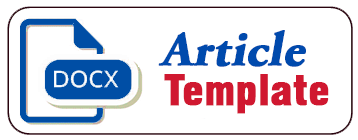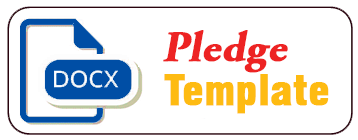Author Guidelines
Author Guideline
ASEAN Journal of Disaster Health Management (AJDHM) is a peer-reviewed platform to publicize disaster health management relevant articles focused on the ASEAN region of original research, case studies and practices, capacity development, and policy recommendations, a collaboration between health sectors and other sectors in disasters, and as well as the world-class review articles. In addition, this journal promotes the WHO Health Emergency and Disaster Risk Management (EDRM) Framework in the region. AJDHM is the official publication of the ASEAN Academic Network on Disaster Health Management (AANDHM).
1. Preparation of the Manuscript
AJDHM accepts several types of manuscripts. The manuscript format is provided for your preparation and submission through the Gadjah Mada University Online Journal System https://jurnal.ugm.ac.id/v3/AJDHM. For more detailed instructions, refer to section 5 in this guideline.
1) Abstract
A single paragraph of about 150-200 words maximum. For research articles, abstracts should give a pertinent overview of the work. Introduction: Place the background of the study. Objective:. Methods: briefly describe the main methods or implementation applied. Results: summarize the article’s main findings. Conclusions: indicate the main conclusions or interpretations. The abstract should be an objective representation of the article and it must not contain results that are not presented and substantiated in the main text and should not exaggerate the main conclusions.
2) Main manuscript
In general, the main manuscript text can be minimum 4,000 and maximum to 6,000 words (excluding title, abstract, keywords, references, acknowledgments, conflict of interest statement, and listed abbreviations). Be careful that 180 words are per figure, and the number of words in tables will be deduced from the total words up to 6,000.
2-1) Original Research
The original research is based on structured research using quantitative and/or qualitative data collection methods and analyses to answer research questions, validate a hypothesis or clarify association(s), or prove a cause-and-effect relationship.
- For the original research manuscript, please provide a concise statement of the study hypothesis or objective after the introduction section of the main manuscript.
- Limitations of the study (potential limits of validity for the report should be discussed) must be discussed, preferably as a separate section, following the end of the Discussion section.
- The Conclusion statement must concisely summarize the study findings without subjective statements, editorialization, or further discussion and should be placed as a final stand-alone section following the limitations discussion at the end of the main text.
- The acknowledgment and Conflict of interest shall be stated in your manuscript.
Preferred Original Research manuscript format is as follows:
- Title
- Abstract
- Introduction (this section includes background, literature review, theories, and objectives)
- Method
- Result
- Discussion
- Limitation
- Conclusion(s) (should be based on the study findings)
- Acknowledgement
- Author contribution
- Conflict of Interest
- Funding
- References (use Vancouver format)
*Tables / Charts / Figures: Cite in order in the main text.
*Abbreviations and symbols: use the word in full (followed by the abbreviation in parentheses) at its first appearance and thereafter use the abbreviation. Abbreviations should not be used in the title.
2-2) Field report/Project report
Field report/Project report summarize project results and implications. It should include a research strategy or approach, the activities, technologies, and details of the project undertaken, conclusions, and recommendations for the future direction of work in the field. The structure is similar to the original research but permits more flexibility.
- These papers provide a direct report of implementation or implications of the practices on DHM, including disaster response, curriculum/training/emergency medical teams/responding mechanism development, and public health in disasters. Supporting maps, graphs, and tables are encouraged to be included with careful caution on copyright clearance.
- Event (hazard) type (earthquake, tropical storm, bombing, train crash, mass-gathering event, infectious diseases outbreak, etc.) or the main topic (medical relief, humanitarian response, public health surveillance, policy/curriculum/training/mechanism development, etc.) should be identified in the A summary of the report with important findings shall be clearly stated in the abstract.
- The introduction should describe the event in detail, including the onset date, location, and impact. Citing the GLIDE disaster ID (https://glidenumber.net/glide/public/search/search.jsp) will help. In addition, summary of event/activity with specific data, such as population density, general damage, response and responsibilities, and objectives of the projects shall be described.
- The methods section should include implementation details relevant to the report. Cite references if any, used in the implementation, field activities, and analytical methods.
- Results, Discussion, and Limitation sections should include the novelty of the findings, comparison with preceding reports, and limitations of the findings. Avoid using “lessons learned” because this terminology blurs your notions.
Field Report/Project Report manuscript format is as follows:
- Title
- Abstract
- Introduction
- Method
- Result
- Discussion
- Conclusion with recommendations and ways forward
- Acknowledgement
- Author contribution
- Conflict of Interest
- Funding
- References (use Vancouver format)
2-3) Case study/Case Report
A case study, case report, or other description and discussion of a particular phenomenon based on original/direct observations. The goal of this study is to make other researchers aware of the possibility that a particular phenomenon and its implications.
- The case presentation section should include case presentation, observations, test results, and associated figures. The case can be a person, a community, a system, and a phenomenon according to the aim of the manuscript.
The Case Study/Case Report manuscript format is as follows:
- Abstract
- Introduction
- Case Presentation (similar to the Field Report)
- Discussion
- Conclusions
- Acknowledgement
- Conflict of Interest
- References (use Vancouver format)
2-4) Review Article
Reviews provide a comprehensive summary and constructive analysis of recent developments/advancements or discussion of an area of scientific research alongside a new perspective or conclusion. Review articles are a vital companion to research articles as they enable research to evolve.
There are several types of review articles, including systematic reviews and meta-analyses, scoping reviews, and narrative reviews. Please refer to Chapter 2.6 and 3.6 of WHO guidance on research methods for H-EDRM to find the appropriate types of review article (https://wkc.who.int/our-work/health-emergencies/research-methods).
Follow the recommended guidelines for each type of review as suggested:
- For a systematic review
- Higgins JPT, Thomas J, Chandler J, Cumpston M, Li T, Page MJ, Welch VA, editors. Cochrane Handbook for Systematic Reviews of Interventions, version 6.0. Cochrane: London. 2019.
- Lockwood C, Oh EG. Systematic reviews: Guidelines, tools and checklists for authors. Nursing and Health Sciences. 2017: 19(3): 273–7.
- Moher D, Liberati A, Tetzlaff J, Altman DG; PRISMA Group. Preferred reporting items for systematic reviews and meta-analyses: the PRISMA statement. Ann Intern Med. 2009;151:264-9.
2. For a scoping review
- Tricco AC, Lillie E, Zarin W, O’Brien KK, Colquhoun H, Levac D, et al. PRISMA Extension for Scoping Reviews (PRISMA-ScR): Checklist and Explanation. Annals of Internal Medicine. 2018: 169(7): 467-73.
2-5) Methodologies or Methods
The Materials and Methods should be described with sufficient details to allow others to replicate and build on the published results. Please note that the publication of your manuscript implicates that you must make all materials, data, computer code, and protocols associated with the publication available to readers. Please disclose at the submission stage any restrictions on the availability of materials or information. New methods and protocols should be described in detail while well-established methods can be briefly described and appropriately cited. Research manuscripts reporting large datasets that are deposited in a publicly available database should specify where the data have been deposited and provide the relevant accession numbers. If the accession numbers have not yet been obtained at the time of submission, please state that they will be provided during review. They must be provided prior to publication.
Interventionary studies involving animals or humans, and other studies that require ethical approval, must list the authority that provided approval and the corresponding ethical approval code
.
2. Figures and Tables
Authors are encouraged to insert the essential figures (including photos) and tables. The files for figures and tables should follow the required format and should be submitted as separate files from the main text. The number of words for a figure is counted as 180 words. The number of words in a table shall be counted within 3,500 words. Please follow the submission format to use those data.
3. English language editing
Authors, particularly those whose first language is not English, may wish to take native-check for their English-language manuscripts before submission. This step is optional, but may help to ensure that the Editor and any reviewers fully understand the academic content of the paper. If the authors request to be provided the English proofreading support from the Universitas Gajah Mada, the Production Unit of AJDHM will announce you with a particular paper submission due date.
4. Format
The submission format is provided by the Production Unit of AJDHM, which is the editorial unit of the Journal. Authors should note that submission implies that the content has not been published or submitted for publication elsewhere except as a brief abstract in the proceedings of a scientific conference or symposium.
Additional requirements are below for your manuscript:
- ORCID: As part of our commitment to supporting authors at every step of the publishing process, the journal requires only the submitting author (corresponding author) to provide an ORCID ID when submitting a manuscript. Please visit herefor more information about ORCID and complete to obtain your ID to apply.
- Ethical Approval: The statement of ethical approval, approval number, approval date, and waiver date should be described in the Method section. Especially when the Ethical Committee or Institutional Review Boards (IRBs) waives the ethical approval, the certification document should be added as a supplementary document.
- Acknowledgements: The contribution of colleagues, patients, community members, institutions, or data sources should be acknowledged.
- Funding: The source of financial grants should be mentioned.
- Conflicts of interest (COI) statement: This statement must disclose any commercial interest of the authors in the findings presented. If there is none, it must be stated that “The authors declare no conflicts of interest.”
5. Ethical Clearence
All authors must submit a certificate from the ethical committee or IRBs to ensure the ethical acceptability of the research protocols for the formal approval or waiver of the research. This approval or waiver should also be stated in the Methods section of your manuscript. In case you have any specific rules in your country, especially for a waiver of ethical approval*, submit the evidence of the document (including public information through a website) as a supplement file along with the manuscript, the pledge** and the cover letter. Please refer to the 2013 revision to the Declaration of Helsinki, which outlines the criteria that investigators must adhere to. When conducting research on people, the Methods section needs to specify if participants were paid a stipend and how informed consent was gained. The manuscript must be submitted via the Online Journal System (OJS) of AJDHM (https://jurnal.ugm.ac.id/v3/AJDHM). The submission instructions can be referred to in the online link.
*Ethical approval is required for studies involving human subjects but not for political analysis, system analysis, or methodological papers without human or animal subjects.
**The pledge includes other principles such as avoiding duplicate publication, protecting personal information, and conflict of interest.








